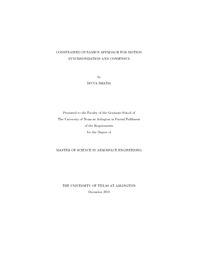
ATTENTION: The works hosted here are being migrated to a new repository that will consolidate resources, improve discoverability, and better show UTA's research impact on the global community. We will update authors as the migration progresses. Please see MavMatrix for more information.
Show simple item record
| dc.contributor.author | Bhatia, Divya | en_US |
| dc.date.accessioned | 2011-03-03T21:50:50Z | |
| dc.date.available | 2011-03-03T21:50:50Z | |
| dc.date.issued | 2011-03-03 | |
| dc.date.submitted | January 2010 | en_US |
| dc.identifier.other | DISS-10970 | en_US |
| dc.identifier.uri | http://hdl.handle.net/10106/5376 | |
| dc.description.abstract | In this research we propose to develop constrained dynamical systems based stable attitude synchronization, consensus and tracking (SCT) control laws for the formation of rigid bodies. The generalized constrained dynamics Equations of Motion (EOM) are developed utilizing constraint potential energy functions that enforce communication constraints. Euler-Lagrange equations are employed to develop the non-linear constrained dynamics of multiple vehicle systems. The constraint potential energy is synthesized based on a graph theoretic formulation of the vehicle-vehicle communication. Constraint stabilization is achieved via Baumgarte's method. The performance of these constrained dynamics based formations is evaluated for bounded control authority.The above method has been applied to various cases and the results have been obtained using MATLAB simulations showing stability, synchronization, consensus and tracking of formations. The first case corresponds to an N-pendulum formation without external disturbances, in which the springs and the dampers connected between the pendulums act as the communication constraints. The damper helps in stabilizing the system by damping the motion whereas the spring acts as a communication link relaying relative position information between two connected pendulums. Lyapunov stabilization (energy based stabilization) technique is employed to depict the attitude stabilization and boundedness. Various scenarios involving different values of springs and dampers are simulated and studied.Motivated by the first case study, we study the formation of N 2-link robotic manipulators. The governing EOM for this system is derived using Euler-Lagrange equations. A generalized set of communication constraints are developed for this system using graph theory. The constraints are stabilized using Baumgarte's techniques. The attitude SCT is established for this system and the results are shown for the special case of three 2-link robotic manipulators.These methods are then applied to the formation of N-spacecraft. Modified Rodrigues Parameters (MRP) are used for attitude representation of the spacecraft because of their advantage of being a minimum parameter representation. Constrained non-linear equations of motion for this system are developed and stabilized using a Proportional-Derivative (PD) controller derived based on Baumgarte's method. A system of 3 spacecraft is simulated and the results for SCT are shown and analyzed.Another problem studied in this research is that of maintaining SCT under unknown external disturbances. We use an adaptive control algorithm to derive control laws for the actuator torques and develop an estimation law for the unknown disturbance parameters to achieve SCT. The estimated disturbance is added as a feed forward term in the actual control law to obtain the stabilization of a 3-spacecraft formation. The disturbance estimates are generated via a Lyapunov analysis of the closed loop system.In summary, the constrained dynamics method shows a lot of potential in formation control, achieving stabilization, synchronization, consensus and tracking of a set of dynamical systems. | en_US |
| dc.description.sponsorship | Subbarao, Kamesh | en_US |
| dc.language.iso | en | en_US |
| dc.publisher | Aerospace Engineering | en_US |
| dc.title | Constrained Dynamics Approach For Motion Synchronization And Consensus | en_US |
| dc.type | M.S. | en_US |
| dc.contributor.committeeChair | Subbarao, Kamesh | en_US |
| dc.degree.department | Aerospace Engineering | en_US |
| dc.degree.discipline | Aerospace Engineering | en_US |
| dc.degree.grantor | University of Texas at Arlington | en_US |
| dc.degree.level | masters | en_US |
| dc.degree.name | M.S. | en_US |
Files in this item
- Name:
- Bhatia_uta_2502M_10970.pdf
- Size:
- 10.39Mb
- Format:
- PDF
This item appears in the following Collection(s)
Show simple item record


